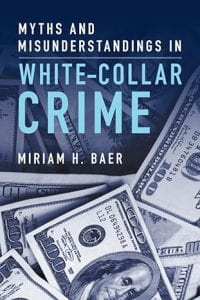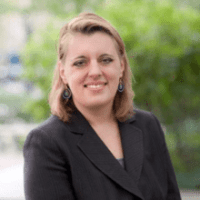
UPDATE: In August 2023 Miriam published her book “Myths and Misunderstandings in White-Collar Crime”. Kelley ICG is proud to have speakers who are continually pushing the boundaries of their fields and creating spectacular content that we can all learn from. Miriam’s book is available for purchase through the Cambridge University Press and Amazon.
On November 3, 2022, presenter Miriam Baer gave the lecture “Minding the Gap in Corporate and White-Collar Crime”
The Q&A from Miriam’s lecture is below.
[1] The model of prototyping to me assumes that prosecutors would follow an institutionalized thought process for determining whether a case is viable. Can you please expound this if this understanding is accurate?
That’s an interesting thought. The Department of Justice displays different degrees of decentralization and centralization. So, on the one hand, cases are handled by United States Attorneys’ Offices, and within those offices, by line prosecutors who report to supervisors. From that perspective, one might say that “viability” is solely in the eye of a single prosecutor. But the prosecutors who work on the more sophisticated cases work in teams, consult with supervisors, and also consult with the federal investigative agents (FBI, SEC investigators, etc.) who have been assigned to the case. Over time, one would expect a “working group” to form, whereby iterative interactions create a “group” version of what is and is not viable. For more on the relationship between prosecutors and their investigative agents (and some flavor of how the DOJ and its components operate), see Daniel C. Richman, Prosecutors and Their Agents, Agents and Their Prosecutors, 103 COLUM. L. REV. 749 (2003).
[2] Curious about the role of judges and juries- in setting what’s considered viable? Fantastic talk!
Even if the vast majority of cases never make it to trial, we know that prosecutors care about what juries think. We also know that prosecutors have them in mind when they choose their federal cases. So what’s interesting about the “jury” question is that it isn’t an actual jury that guides the prosecutor’s choices, but instead a hypothetical one. My point – as outlined in this chapter – is that salient losses such as the Bear Stearns acquittal are likely to impact the prosecutor’s view of that hypothetical jury. Indeed, I would expect the match between a win (Worldcom cases) and a loss (Bear Stearns) to be particularly influential on one’s thinking. For a nice ethnographic account of juries and how they impact the federal prosecutor’s thinking, see Anna Offit, Prosecuting in the Shadow of the Jury, 113 NORTHWESTERN L. REV. 1071 (2019) and her recent book, THE IMAGINED JUROR (2022).
The story I am telling is a story about why prosecutors fail to bring cases in the first place – so judges are not directly implicated in this story. But judges do sometimes comment on viability issues. Judge Rakoff very famously questioned the dearth of corporate officer prosecutions in the wake of the Financial Crisis. One could argue that he was, in effect, questioning the government’s sense of viability. Notice, he couldn’t address that issue head-on. He instead had to bring it up separately in a NY Review of Books essay.
[3] The SEC has long turned a blind eye to fraud in over-the-counter markets and small-cap stocks. Instead, the agency stresses that US capital markets are efficient and fair. Many market participants disagree. Lack of resources results in the agency focusing only on large firms and high-profile cases. How can one encourage the agency to look at small company cap fraud without additional resources?
This might be one of those areas where journalists can play an important role. If a small-cap company fraud becomes the subject of a well-reported article (or podcast or television show), the story can attract the attention of regulators and prosecutors. That would be most helpful if it’s simply a case of the agency not wanting to use its resources this way. If instead it’s a case of not enough information, a whistleblowing program targeted towards small-cap companies might be of some use.
[4] What are your thoughts on DOJ’s discusse emphasis on individual accountability in Corporate Criminal acts and do you think that will chnage the gap?
Deputy Attorney General Lisa Monaco announced the Department’s newest policy on corporate leniency in a speech given at NYU Law School on September 15, 2022. I have no doubt that DAG Monaco is sincere in expressing the DOJ’s desire to secure evidence against corporate officers, but I see more continuity in the government’s framework than differences. The government still plans to offer corporate offenders leniency in exchange for voluntary disclosure. The “new” policy simply makes clear that for a corporation to receive cooperation credit, it has to promptly disclose information indicating an officer’s specific liability. Now, I seriously doubt any corporate defense attorney would admit to purposely delaying or withholding relevant evidence of wrongdoing. And I also doubt any prosecutor ever said, “Yeah sure, I don’t mind if you strategically withhold evidence from me” to any corporate counsel. So, it seems to me that what the announcement is doing is describing a tonal change – “we want your evidence” earlier – more than a true change in policy.
The announcement also provides greater assurances that a corporation’s voluntary self-disclosure will result in neither a guilty plea nor an independent monitor. That type of predictability is helpful and certainly may help compliance officers convince corporations to be more proactive in their internal monitoring.
But notice – all of this is the stuff of gap-minding – of improving enforcement on the margins and allowing the government to make a few cases more quickly and easily than it otherwise would be able to do. That’s hardly a bad thing, but it isn’t the same thing as gap-narrowing.
[5] Do you think this model can be applied in a scenario where the judiciary is subservient to the executive and where different yardsticks when it comes to the rule of law?
It might be interesting to ask how the model might work in civil enforcement context, where the burden of proof is different and where multiple actors (private plaintiffs, for example) can bring lawsuits. In that instance, multiple stakeholders would have a chance to weigh in on where the viability line should fall. I would expect viability to be far more transparent than it is in the criminal context.
[6] How much variability is there in this (subjective) assessment of viability (say, we quantify this as probability of success) between prosecutors?
I would expect variability to turn on a number of factors – turnover, degree of centralization, and degree of homogeneity among prosecutors. When a prosecutor’s office is particularly “tight” – i.e., the prosecutors work in teams, report to a supervisor, share a common culture and subscribe to certain well-understood norms, the variability in the assessment of viability ought to narrow. When the office is highly decentralized and no-one works with or reports to anyone other than a single U.S. Attorney, one should expect a higher variance. The prosecutors’ offices with which I am familiar (I gained my own experience in the U.S. Attorney’s Office for the Southern District of New York) are far more like the former than the latter. For a very nice discussion of the ways in which prosecutor’s offices can differ – and the implications these structural differences have for how cases are chosen and prosecuted – see Kay Levine and Ronald Wright, Prosecution in 3D, 102 J. CRIM & CRIMINOLOGY 1119 (2013).

Miriam Baer is the Vice Dean and a Centennial Professor of Law at Brooklyn Law School. During the 2021-22 academic year, she was a Visiting Fellow at Harvard University’s Edmond J. Safra Center for Ethics, where she worked on her forthcoming book, Myths and Misunderstandings of White-Collar Crime (Cambridge University Press, forthcoming).
Dean Baer writes and teaches at the intersection of business and criminal law. She is an elected member of the American Law Institute, where she served as an Adviser on the ALI’s Principles of the Law of Compliance, Enforcement and Risk Management. Before academia, Dean Baer served as an assistant general counsel for compliance with Verizon and was also an Assistant U.S. Attorney in the Criminal Division of the U.S. Attorney’s Office for the Southern District of New York.
Baer is often quoted by major media outlets on issues of federal and white-collar crime. She has published widely, including in the Columbia Law Review, Virginia Law Review, Texas Law Review, Michigan Law Review, Minnesota Law Review, and the Yale Law Journal Forum. She is also a co-editor of a leading white-collar crime casebook and has had her work featured and cited by several federal appellate courts.
For further information on the webinar please contact Professor Jun Yang, Director of the Institute for Corporate Governance at icg@indiana.edu.